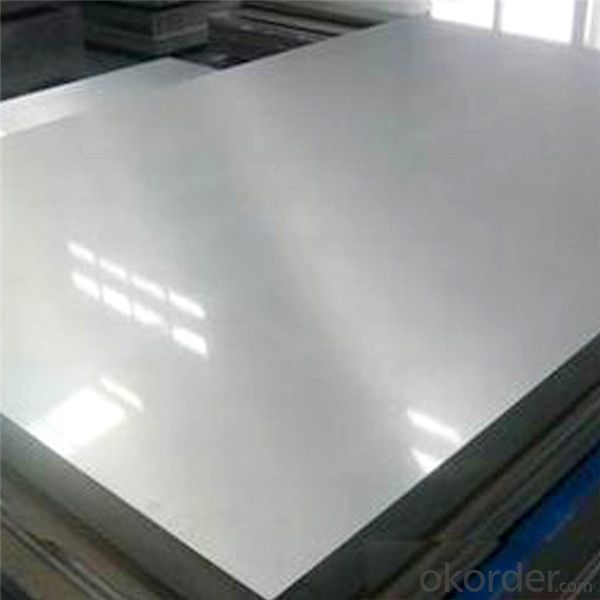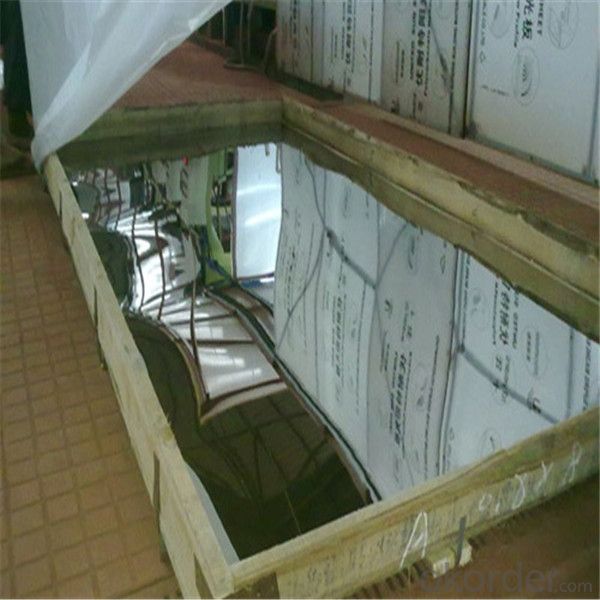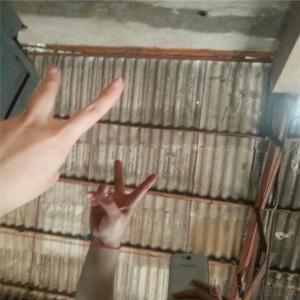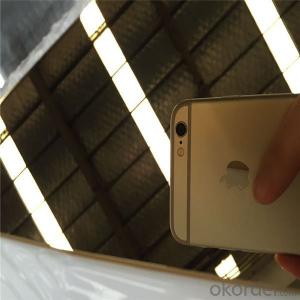321 Stainless Steel Sheet perfect price and strong hardness
- Loading Port:
- Shanghai
- Payment Terms:
- TT OR LC
- Min Order Qty:
- 2 m.t.
- Supply Capability:
- 20000 m.t./month
OKorder Service Pledge
OKorder Financial Service
You Might Also Like
Item specifice
perfect price and strong hardness 321 stainless steel sheet
Product Description
| Item | perfect price and strong hardness 321 stainless steel sheet |
| Material | 321 |
| Standard | ASTM EN AISI DIN |
| Length | 1000-6000mm.can be cut as customized |
| Width | 1000mm,1219mm,1500mm,or as customized |
| Thickness | 0.3-3mm |
| Color | bronzen,emerald green,pink,rose gold,champagne,violet,antique copper,sapphire,wine red,etc |
| Finish | NO.2,NO.4,8K,brushed,etc |
| Application | 1.Oil combustion exhaust pipes |
| Packaging | standard export seaworthy package |
| Delivery time | 7-10 days after the confirmation of the deposit. |
| payment terms | T/T,L/C |
we provide the best price
we are specialized in stainless steel, we provide the best quality ever
we have strong quality control system: Raw material control/process control/component quality control/finished product quality inspection/mass production spot check/inspection company check
we provide the most efficient and effective work. (Quotations will be sent within one business day)
we provide the most efficiently lead time
we quickly responese for any questions and provide solutions effectively
large inventory


- Q:Are stainless steel sheets resistant to saltwater?
- Indeed, saltwater poses no threat to stainless steel sheets. Renowned for its ability to resist corrosion, stainless steel demonstrates exceptional suitability for environments with extensive saltwater contact. The chromium present in stainless steel creates a protective layer over the metal's surface, effectively warding off rust and corrosion. As a result, stainless steel sheets prove to be an exceptional option for various marine applications, including boat construction, offshore structures, and coastal infrastructure. Moreover, stainless steel's resilience against saltwater renders it fitting for other purposes such as coastal architecture, kitchen equipment, and medical instruments.
- Q:What are the different types of stainless steel sheet surface patterns available?
- There are several different types of stainless steel sheet surface patterns available, each with its own unique characteristics and aesthetic appeal. Some of the most common patterns include: 1. Brushed: This pattern is achieved by lightly brushing the stainless steel surface with an abrasive material, creating a smooth and uniform texture. It is commonly used in applications where a sleek and modern look is desired. 2. Mirror: This pattern involves polishing the stainless steel surface to a highly reflective finish, resembling a mirror. It is often used in decorative applications where a high level of shine is desired. 3. Satin: Also known as a brushed or hairline finish, this pattern is achieved by applying a fine abrasive material to the stainless steel surface in a linear motion, resulting in a matte appearance. It is commonly used in architectural and kitchen applications. 4. Embossed: This pattern involves imprinting a design or texture onto the stainless steel surface using a patterned roller or press. It can create a variety of decorative effects, such as raised or recessed patterns, and is often used in interior design and automotive applications. 5. Perforated: In this pattern, the stainless steel sheet is punched with a series of small holes in a regular pattern. This allows for enhanced ventilation and drainage capabilities and is commonly used in architectural and industrial applications. 6. Etched: This pattern involves chemically treating the stainless steel surface to create a design or pattern. It can be used to create intricate and detailed designs, making it popular in decorative and artistic applications. These are just a few examples of the different types of stainless steel sheet surface patterns available. The choice of pattern often depends on the desired application, functionality, and visual appeal.
- Q:Are stainless steel sheets suitable for elevator control panels?
- Yes, stainless steel sheets are suitable for elevator control panels. Stainless steel is known for its durability, resistance to corrosion, and ease of maintenance, making it a popular choice for various applications including elevator control panels. It provides a sleek and modern appearance, can withstand constant use and touch, and is easy to clean and disinfect, making it an ideal material for elevator control panels.
- Q:Are stainless steel sheets good for heat exchanger tubes?
- Stainless steel sheets are widely employed as heat exchanger tubes owing to their remarkable heat transfer capabilities and resistance to corrosion. The thermal conductivity of stainless steel is notably high, enabling efficient heat transfer between fluids. Moreover, its exceptional resistance to corrosion is vital for heat exchangers that frequently encounter corrosive liquids or gases. The longevity and reliability of stainless steel sheets guarantee the durability of heat exchanger tubes, making them a favored option in diverse industries like chemical processing, power generation, and HVAC systems.
- Q:What is the maximum temperature that stainless steel sheets can withstand?
- The grade of stainless steel used determines the maximum temperature that stainless steel sheets can endure. Typically, stainless steel is recognized for its exceptional resistance to heat and can endure temperatures between 1200°F and 1600°F (650°C and 870°C). Nevertheless, the precise temperature limit can differ based on the grade of stainless steel, the sheet's thickness, and the duration of exposure to elevated temperatures. To ascertain the maximum temperature tolerance for a particular stainless steel sheet, it is crucial to refer to the manufacturer's specifications or consult a materials engineer.
- Q:How do you prevent galvanic corrosion when using stainless steel sheets?
- To avoid galvanic corrosion when utilizing stainless steel sheets, there are several precautions you can take: 1. Steer clear of direct contact with dissimilar metals: Galvanic corrosion arises when two different metals make contact in the presence of an electrolyte, such as moisture. To prevent this, ensure that stainless steel sheets do not come into direct contact with dissimilar metals, particularly those with a higher anodic index, such as aluminum or copper. If contact cannot be avoided, utilize insulating materials like plastic or rubber gaskets to separate the metals. 2. Choose compatible fasteners: When securing stainless steel sheets, it is essential to select fasteners crafted from the same or compatible metals. The utilization of dissimilar metals can form galvanic cells, resulting in corrosion. It is recommended to use stainless steel fasteners or those composed of materials with similar corrosion resistance, such as galvanized steel. 3. Apply protective coatings: The application of protective coatings on stainless steel sheets can serve as an additional barrier against galvanic corrosion. Consider utilizing paint, epoxy, or other suitable coatings that are compatible with stainless steel. These coatings act as sacrificial layers, preventing direct contact between the stainless steel and the surrounding environment. 4. Insulate electrical connections: If stainless steel sheets are involved in electrical systems, ensure adequate insulation of electrical connections. This prevents the flow of electrical current between dissimilar metals, reducing the risk of galvanic corrosion. Insulating materials like plastic or rubber sleeves can be employed to separate the metals and impede the formation of galvanic cells. 5. Regulate environmental factors: Galvanic corrosion is often accelerated in the presence of moisture, saltwater, or acidic environments. Controlling these factors can help prevent corrosion on stainless steel sheets. Routinely clean and dry the sheets, particularly in areas where moisture accumulates. Avoid exposing the sheets to saltwater or corrosive chemicals, and maintain proper ventilation to minimize humidity levels. By implementing these preventive measures, you can significantly diminish the likelihood of galvanic corrosion when using stainless steel sheets. However, it is crucial to regularly inspect the sheets for any indications of corrosion and promptly address them to uphold their integrity and longevity.
- Q:Can stainless steel sheets be bent?
- Stainless steel sheets have the capability to be bent. This material, known for its versatility, can be molded into different forms and designs, including bends. The capacity to bend stainless steel sheets relies on their thickness and composition. Generally, thinner sheets are more pliable and easier to bend, whereas thicker sheets might necessitate specialized tools and techniques. It is crucial to bear in mind that the bending procedure could potentially weaken the strength and durability of the stainless steel sheet. Therefore, careful thought should be given to the particular application and requirements before embarking on the bending of stainless steel sheets.
- Q:Can stainless steel sheets be custom-cut?
- Stainless steel sheets have the capability to be tailored to specific sizes and dimensions. This adaptable material can be easily molded and formed to meet individual needs. The custom-cutting of stainless steel sheets is widely practiced across multiple industries, including construction, manufacturing, and fabrication. This procedure guarantees a precise fit for various purposes, such as architectural projects, machinery components, or kitchen equipment. Expert metal fabricators or specialized service providers commonly employ advanced techniques like laser cutting, waterjet cutting, or shearing to accurately customize stainless steel sheets according to desired specifications.
- Q:Can stainless steel sheets be used for electromagnetic shielding?
- Yes, stainless steel sheets can be used for electromagnetic shielding. Due to its high electrical conductivity and magnetic permeability, stainless steel can effectively block electromagnetic radiation and protect sensitive electronic devices from interference.
- Q:How do you remove water spots from stainless steel sheets?
- To remove water spots from stainless steel sheets, you can follow these simple steps: 1. Start by thoroughly cleaning the surface with a mild dish soap and warm water solution. This will remove any dirt or grime that may be contributing to the appearance of water spots. 2. Rinse the sheets with clean water and dry them completely using a soft cloth or towel. This step is important to prevent any new water spots from forming during the cleaning process. 3. Next, prepare a solution of equal parts white vinegar and water. Dip a clean cloth or sponge into the solution and wring out any excess liquid. 4. Gently rub the affected areas of the stainless steel sheets with the vinegar solution-soaked cloth or sponge. Be sure to follow the grain of the stainless steel to avoid scratching the surface. 5. After rubbing the water spots, rinse the sheets with clean water and dry them thoroughly once again with a soft cloth or towel. 6. If the water spots persist, you can try using a stainless steel cleaner or polish specifically designed for removing stains and water spots. Follow the instructions provided with the cleaner, and be sure to test it on a small, inconspicuous area first to ensure it does not damage the stainless steel. Remember to always use soft materials and gentle cleaning techniques when dealing with stainless steel to avoid scratching or damaging the surface.
1. Manufacturer Overview |
|
|---|---|
| Location | |
| Year Established | |
| Annual Output Value | |
| Main Markets | |
| Company Certifications | |
2. Manufacturer Certificates |
|
|---|---|
| a) Certification Name | |
| Range | |
| Reference | |
| Validity Period | |
3. Manufacturer Capability |
|
|---|---|
| a)Trade Capacity | |
| Nearest Port | |
| Export Percentage | |
| No.of Employees in Trade Department | |
| Language Spoken: | |
| b)Factory Information | |
| Factory Size: | |
| No. of Production Lines | |
| Contract Manufacturing | |
| Product Price Range | |
Send your message to us
321 Stainless Steel Sheet perfect price and strong hardness
- Loading Port:
- Shanghai
- Payment Terms:
- TT OR LC
- Min Order Qty:
- 2 m.t.
- Supply Capability:
- 20000 m.t./month
OKorder Service Pledge
OKorder Financial Service
Similar products
New products
Hot products
Hot Searches
Related keywords





























